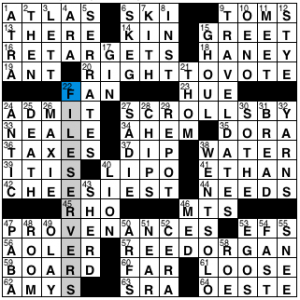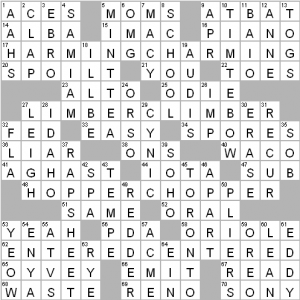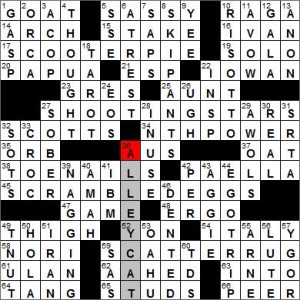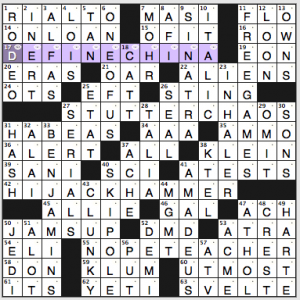NYT 3:36
LAT 3:47 (Neville)
CS 4:16 (Sam)
Jonesin' untimed
Chris A. McGlothlin’s New York Times crossword
I love the theme of short intersecting pairs (laid out with perfect symmetry, too) and the way it allows all those long answers to pop (RIGHT TO VOTE, FILE SERVERS, WENT SOLO, etc.). The heavy-duty cross-referencing in the clues was annoying at first but then the pairs started laying themselves out and I began looking for “X and Y” phrases that would fit the clues and the answer locations. But I don’t like how the tradeoff is a smattering of junk fill.
The theme pairs appear in symmetrical places, and each and every one follows the same directionality—for every “X and Y,” X is the Down and Y is the Across. The pairs are:
- 2d, 13a. THEN and THERE, [on the spot].
- 7d, 14a. KITH and KIN, [family]. Uh, not really. KIN is family, but the KITH includes your friends and acquaintances.
- 11d, 15a. MEET and GREET, [get-to-know-you gathering].
- 25d, 36a, DEATH and TAXES, [two of life’s certainties].
- 28d, 37a. CHIPS and DIP, [snack option].
- 31d, 38a. BREAD and WATER, [meager meal].
- 48d, 59a. ROOM and BOARD, [lodger’s fee].
- 51d, 60a. NEAR and FAR, [all around].
- 54d, 61a. FAST and LOOSE, [one way to play]. How come I never noticed that “fast and loose” includes two antonyms if you go with fast = “firmly attached” rather than “speedy”?
Neat stuff.
In the debit column, we have the plurals (including a possessive that looks like a plural in the grid) TOMS, MTS, AMYS, EFS. We have an funky obscurish word, 6d: SKEG, [Surfboard fin]. Not common knowledge, methinks. Crossword overuse victims ATRA, PABA, LETT, ARA, SHERD. OENO, STYE, and SNEE. Unfamiliar characters Mr. HANEY (saw him once in a crossword) and MAXIE. The TOMS/THOM near duplication. Foreign OESTE. That’s a lot of forgiveness that the theme has to ask for.
I don’t know whether a Patrick Berry could pull off the same theme with markedly better fill, or if the criss-crossed answers locking down nine chunks of grid makes it inevitable. I’d love to have more seasoned constructors than I weigh in on the subject so I can decide if this is a 4-star puzzle because of its nifty theme or a 2.75-star puzzle because the fill places it in the below-average category.
Doug Peterson’s CrosSynergy/Washington Post crossword, “Middle C” – Sam Donaldson’s review
Great theme! If I have seen this gimmick before, I don’t remember it. Doug finds six- and seven-letter words that can be converted to new seven- and eight-letter words through the addition of a C at the front. He then pairs the before-and-after words together to make new, wacky phrases that get their own creative clues. Because the longer word always comes after the shorter word, the C always appears in the middle of the answer. Check it out:
- 17-Across: Add a C to the front of HARMING, then pair up the results. You get HARMING CHARMING, or [Doing injury to a fairy tale prince?].
- 27-Across: Repeat the same procedure with LIMBER for LIMBER CLIMBER, a [Successful cliff scaler, usually?]. This is the only pair in the set where the words don’t rhyme, and as a result it lacks the same roll-off-your-tongue effortlessness of HARMING CHARMING. But even with the inconsistency I’m still allowed to like it, and I do.
- 48-Across: Just the other day I was wondering what to call a [Vehicle for a bunny in a biker gang?]. Turns out it’s a HOPPER CHOPPER.
- 62-Across: One who has [Walked onstage with calm confidence?] has ENTERED CENTERED. If you exit with a split personality, perhaps you have LEFT CLEFT.
The repeating letters in each theme entry facilitated a speedy solve (for this comparative tortoise, at least). You know what else facilitates a speedy solve? Clean fill and lively clues, that’s what. And this grid is uber-smooth. Geography is usually one of my many weak subjects, but today’s assembly of TEMPE, TORONTO, FLA, WACO, and IDAHO were all within my wheelhouse. True to form, there’s some baseball references here, with both an AT BAT and a Baltimore ORIOLE. I loved the conversational southwest corner with YEAH, YEOW, and OY VEY. Best of all, there was the nice shout-out in SAM I AM, the [“Green Eggs and Ham” character].
Favorite entry = TIM TEBOW, the [NFL quarterback known for kneeling]. Favorite clue = [Destination for yellow buses] for SCHOOL. I don’t know why, but I remember this clue putting a smile on my face. Honorable mention to [Hathaway of “The Dark Knight Rises”]. Any guess as to what movie Doug’s looking forward to seeing in a couple of weeks?
Marti DuGuay-Carpenter’s Los Angeles Times crossword – Neville’s review
Git!
- 17a. [Marshmallow-and-cookie layered treat] – SCOOTER PIE
- 27a. [Meteor shower phenomena] – SHOOTING STARS
- 45a. [Brunch fare] – SCRAMBLED EGGS
- 59a. [Small carpet] – SCATTER RUG
- 36d. [Stray that might evoke the start of 17-, 27-, 45- or 59-Across] – ALLEY CAT
Pretty neat that the four main theme answers all started with S, right? We’d still have had symmetric theme entries if we’d gotten rid of pluralizations, though. That’s gotten rid of the nasty big blocks on the left and right. I’ll bet MDG-C tried that, though.
Tough clue right out the gate with [Musing] for THOUGHT; that’s the old gerund trick. Likewise my first guess for an A word for [Reunion attendee] was ALUM, not AUNT. Today Tuesday is tough as TOENAILS.
We may have an AGGIE in the puzzle, but there’s another Texas university getting a spotlight in this grid: Rice.
- 10d. [Ristorante rice dish] – RISOTTO. I have a Pavlovian connection between Risotto and chef Gordon Ramsay, who seems to hate every risotto that people cook for him on his various TV shows. “Too much salt in the bloody risotto!”
- 42a. [Spanish saffron-flavored dish] – PAELLA. It frustrates me to no end when adults can’t pronounce this. Also: quinoa. If you’re reading this, you’re probably on board, though.
Matt Jones’s Jonesin’ crossword, “The Big Build-Up”
Neat theme, which I confess I didn’t really pick up on when I first solved this puzzle. Why are those two letters added to each theme answer? DE, ST, HI, NO … that spells desthino, which isn’t a word. But the sequence of the first three letters is the key. FINE CHINA starts with an F, and the alphabetical sequence DEF becomes the beginning of DEFINE CHINA. Similarly, STU, HIJ, and NOP are also alphabetical chunks.
- 17a. [Write down “Vast Asian country with a population of over a billion”?], DEFINE CHINA.
- 27a. [Crazy situation in “The King’s Speech”?], STUTTER CHAOS.
- 42a. [Steal a parachute pants-wearing rapper’s plane?], HIJACK HAMMER.
- 55a. [Leader of the course “Denial 101”?], NOPE TEACHER.
Fab four:
- 33d. [Hundreds of rap videos?], BENJAMINS. Meaning “hundred-dollar bills, in rap videos.”
- 37a. [It ain’t nothing], ALL. This is true.
- 61a. [Favorite word of nitpicky grammarians], ITS. Or IT’S. One of those. English is really a stupid language, if you think about it. Possessives are made by adding apostrophe-S. The possessive of “it” would seem to be “it’s,” if you’re following the rules. But no! You have to ignore that clear logic, put it out of your head entirely. The possessive of “it” is “its,” and the analogue is another possessive pronoun, like “his,” which has no apostrophe. But this is bogus because the male pronoun is “he,” not “hi,” and it would make sense if the possessive were “hes.” But no. “It’s” is strictly a contraction of “it is,” but all that drilling into people’s heads that “apostrophes are for possession, not plurals” makes them really want “it’s” to be a possessive. And then! It gets worse. Single letters and abbreviations with periods get pluralized with … yes, it’s true, I’m not pulling your leg … apostrophe-S. “Mind your P’s and Q’s” has two plurals and no possessives at all. So quit giving the stink-eye to people who mix up their “its” and “it’s.” Our keyboard fingers have muscle memory for both, and all the wildly conflicting rules don’t make it easy for the brain to overpower whichever version the hands are trying to make. (But if they think its’ is a word, mock them mercilessly. But wait! What if you want to pluralize “its” or “it’s”? What then?)
- 43d. [Really inelegant], CLUNKY. I like this word.
Mystery items:
- 19a. [___ Productions (“Skyfall” company)], EON. Don’t know Skyfall or Eon.
- 6d. [Chant from the cult horror classic “Freaks”], ONE OF US. Never saw it.
- 9d. [“Witchcraft” singer], SINATRA. Don’t know the song. Frank or Nancy?
- 18d. [“E! News” co-host Sadler], CATT. Who?
- 44d. [“Oracular Spectacular” band], MGMT. Have heard of the band but know none of its songs.
3.75 stars.




AMYS was a debit?
Pat Buttram played Mr. HANEY on Green Acres. With Frank Cady’s passing a few weeks ago, I’m not sure that any of the major characters from that show is still alive.
Yes. I don’t have so many EGOS that the plural of my own name isn’t still a debit. Plural names are scarcely more beloved than partials and plural abbreviations.
say there are two puzzles. their themes are different, but of equal merit. they have equally junky fill. but the fill quality of the first is a result of the theme constraints, and the second of constructor inexperience. is the first puzzle better? does the first puzzle deserve a higher rating?
Sherd? Really?
Brent H: I heard the pig, Arnold Zieffel, is still alive and kicking in Burbank. His next door neighbor is David Horowitz.
NYT:I don’t care what the dictionaries say, when speaking of pottery bits, sherd should be the primary spelling, with shard the variant. No one says potshard, do they? Potsherd has been around since the 14th century, long enough for it to have co-opted sherd from that other spelling.
Erik: In your hypothetical comparison, I’d say neither puzzle is better. As for rating, that’s a more subjective matter. When you say the themes are of equal merit, does that imply that the one by the (presumably) more experienced constructor is more ambitious—hence constraining the fill quality—yet is still no better than the other theme?
that’s exactly what i’m saying, i think. also, i totally thought a potsherd was someone who herded pots.
If we take the theme answers as given, there is still (thanks to the symmetry of the theme answers) a fair amount of flexibility in the grid design. With such a constraining theme, it will pay serious dividends down the road if you take full advantage of any flexibility you have to design a less constraining grid.
By my count this puzzle stands at 40 blocks, 76 words. I think I would slightly redesign the center region by perhaps putting a block at the first S of SCROLLSBY, deleting the pair of cheaters this introduces (at the end of SKEG and GIN), and adding a block at the D of TRAVELDATES. This pushes us to 78 words while holding at 40 blocks. What it *accomplishes* is that it gets rid of a pair of long entries (TRAVELDATES and FILESERVERS) that intersect multiple other long entries.
I suspect it will make a huge difference to cut down on those intersecting long answers. In this puzzle, a couple extra long words will not be missed, and just that change will breed significantly higher quality fill (both short and long). Normally in a themed puzzle there are, what, 2 or 4 longish pieces of fill? But when a theme has a lot of short stuff in it, you are naturally going to end up with plenty of longer fill — more than people expect or demand — so there’s no reason to reduce the word count below 78 like this.
That’s a quick fix. Messing more seriously with the grid, or with the theme answers themselves, is another discussion. But if you still weren’t happy with the fill quality after doing the above, another quick fix would be to simply get rid of KITH and KIN, NEAR and FAR. Though short, they run through several of the long fill entries, and they won’t be missed by anyone who never knew they were there. (I’m a fan of density though if you can keep your fill standards high).
NYT: Very interesting discussion re the trade off of theme vs. fill and thinking more about grid design! I liked the idea of the theme — Moving away from the standard long answers for a change and underscoring stock combinations of words that have taken on a specific meaning. And I liked some of the long answers, e.g SCROLL BY. But I also agree that there was a price to pay.
If we’re rethinking design, I’d say a + in the center would have been apt.
My quick and dirty index of puzzle difficulty says that this is in the challenging range for a Tuesday. Part of it is all the hopping and cross referencing.
The NYT was amusing to me because I usually dislike jumping around, and then it turned out to be the main idea! Ha. I wouldn’t reduce the density of the theme pairs for the sake of “better” fill — if you’re going to feature jumps, then the more the merrier! Nice trick…
@Xan: I’m not sure whether losing the long interesting non-themers and having the fill be cleaner is always the best choice, especially in a puzzle with short theme entries like this one…
I actually thought the fill was not too bad, considering how overconstrained the grid was.
@Gareth, I don’t think there’s a “right” answer to the question of how to balance better long answers versus better short ones. That’s a matter of personal taste, but let’s say I was invoking Amy’s preferences, which we are all familiar with.
In any case, though, when losing just a couple long answers will make the long answers themselves significantly better on average, in addition to helping the shorter fill…then it’s harder to argue for more long answers. I think that’s the case here, so I would definitely take it from 10 long non-themers to 8 more interesting long non-themers plus better fill.
Frank. Witchcraft
Revisiting my earlier comment because there was a subtlety to it, expressing what I didn’t grasp in Erik‘s scheme. I proposed that the experienced constructor’s theme was somehow more ambitious yet ultimately no better than the inexperienced constructor’s theme (regardless of the other fill and the puzzle overall), which was tentatively confirmed. I’m not sure how to parse that.
• Was the EC’s theme more ambitious but relatively lame? If that’s the case, then it’s an indulgent choice.
• Was the IC’s theme overambitious for his skills? If that’s so, then it’s a poor choice to publish.
In either instance poor judgment is evinced by both constructor and editor, though of differing character. I suppose it comes out in the wash. I can’t help but think that I’m overreading the original scenario.
For the record, I didn’t enjoy solving this puzzle, but might have had a less annoying experience if I’d done it on paper rather than in Across Lite.
Being a scientist, I view these puzzles the way I look at experiments. Some are beautifully designed, solid, informative, but they have a me-tooish feel. We need them to continuously build on knowledge, or in the case of puzzles, provide a flow of entertainment. Then there are experiments that are a little crazy and break the mold. Knowledgeable people might tell you not to bother because odds of success are low, but even when they fail or only succeed partially, they can be incredibly instructive, and plant a seed for others. Finally, there’s what we dream of in science– the perfect experiment, creative, brilliant, and wildly successful. It’s worth all the failures and you can never get there via imitation. So, I’m always cheering for experimentation and new ideas.
it’s/its: I’m accustomed to irregularities in English and this is a minor one. As for the pile-ons, my personal styles heet doesn’t include apostrophes for pluralized single letters and abrrevs. And of course the plurals of its andit’s are their and theirs, which strengthen the analogy of its with his/hers/ours. It’s minor and should be easy enough to learn.
Okay, most of us are prone to at least occasionally making the muscle memory mistake while typing. That’s understandable. What is not is misspelling one for the other in printed matter (signs, menus, articles, et cetera).
CS: I strongly disagree with 29d [One who assumes the worst] CYNIC. A cynic is not a pessimist.
@pannonica: I meant the plural of the word “its” and the word “it’s.” As in “How many itses and it’ses are in that paragraph?” (Granted, one would write “occurrences of the word ‘its’ and the word ‘it’s.'”)
Oh Huda, don’t misunderstand. I have the same feelings actually (science and art background here, by the way). I meant to imply that if something is imperfect or unsatisfactory that perhaps it should be shelved and revisited, not that it should be scrapped entirely. In the context of a widely published standard puzzle.
There wouldn’t have been the innovations and variations in crosswords that we enjoy so much without experimentation and creativity. Unlike in science, however, you shouldn’t (widely) publish a flawed or failed (standard) puzzle the way you can a study with “unsatisfactory” results, so people can build on it with further insight and creativity.
Art, as brutal as it can be in the commercial sphere, is similarly flexible and forgiving.
I too am cheering for experimentation and new ideas. And since we can’t know everything sometimes it’s only in retrospect that we can appreciate such genius. History is littered with rediscoveries of that sort.
Apologies if this has come across has disjointed; I’m not at my best at the moment. Then again, this is only an informal comment on a blog.
Amy: Yes. Punctuation to the rescue!
Have I mentioned that I’m not at my most cogent/coherent?
@pannonica, i’m now confused by my own hypothetical situation. shame on me. i agree with you about bad judgment.
is a break point worse when it’s a double fault?
Erik: You’re most likely not in the wrong. See the above caveats re: me. And now I must go, to (a) accomplish non-on-line things (b) not create a stranglehold in the comments. (speaking of indulgence and flaws!)
pannoica, why do I believe you have been accused of being a cynic? What does anyone have to gain by such labeling?
While M-W doesn’t define cynic as a pessimist, it does include it as a synonym, along with misanthrope and naysayer. Sadly, it also lists misogynist as a related word.
Hear hear, Huda! Even though I might not enjoy ground-breaking puzzles while in process, I think they’re important in pushing the boundaries.
CS: The creative CYNIC in me enjoyed TIMTEBOW intersecting WACO.
Art